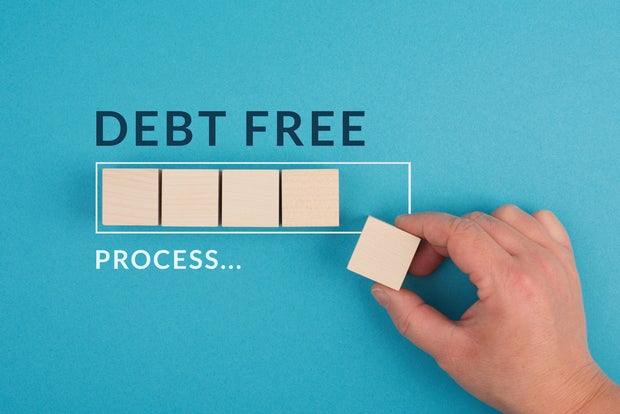Our Terms & Conditions | Our Privacy Policy
4 debt relief moves to make before June
The process of eliminating your debt can start this June, if you take certain steps right now.
Getty Images
The start of a new month can give many people the motivation to reevaluate their goals. And for millions of Americans right now, a top goal remains getting out of debt. With average credit card debt balances around $8,000 currently, for example, and with the median credit card interest rate just under a record 23%, this goal has taken on added urgency. Combined with the likelihood that higher interest rates will be sticking around a bit longer than many borrowers would prefer, the final days of May may be a smart time to start considering debt relief options.
As you embark on this process, however, it can be easy to be overwhelmed by the vast array of solutions available and the decisions you’ll have to make. In this instance, it helps to be diligent and strategic. To that end, we’ve gathered four debt relief moves you may want to consider making before June 1. By making these moves now, in the final days of May, you can better improve your chances of debt relief success in June and in the months that follow.
Start by checking your credit card debt relief eligibility here.
4 debt relief moves to make before June
Here are four smart debt relief moves to consider making before June 1, 2025:
Re-evaluate your budget
Before proceeding with any specific debt relief service, make sure to first re-evaluate your budget for opportunities to fix your debt on your own. Maybe the removal of an unnecessary expense or two could give you the edge you need to make extra payments toward your debt and, thus, reduce it more rapidly than you already have. Or maybe you can work to reduce your current bills by cutting down on services or items you’re being billed for that you don’t use and don’t need. If you can get out of debt on your own by making some small but important budget adjustments, then it’s generally worth doing, as many debt relief options will come with a cost. So start here, on your own, first.
Learn which debt relief option would be applicable for you now.
Be realistic about your ability to pay down debt
The federal funds rate, controlled by the Federal Reserve, impacts interest rates on a variety of products, even if it doesn’t directly dictate them. And, right now, that rate is elevated and isn’t expected to be cut until at least July, if not later in 2025. When that cut does come, it’s expected to be in the amount of just 25 basis points, meaning that relief that trickles down to credit card users or those with personal loan debt will be negligible. Understanding this reality, then, combined with your ability to pay down your debt independently, can help you better decide if a debt relief option is your next step.
Start exploring your debt relief options
There are a multitude of debt relief types to explore, ranging from the extreme in bankruptcy to credit card debt forgiveness to less critical but still helpful types like credit counseling and debt management programs. All can be useful, and all can put you back on the path to regaining your financial freedom. But not all, or even most, will apply to your unique debt situation, so start exploring them now, in advance of an application, to determine which is right for you. By reading reviews of companies, understanding how each type works and checking the qualifications of each, you can move to the next step by preparing your paperwork.
Determine what documentation will be required
Depending on the particular debt relief strategy in question, you’ll likely need to provide some form of documentation to the servicer. With credit card debt forgiveness, for example, proof of financial hardship demonstrating an inability to make your payments may be requested before you can qualify. In this instance, you may need documentation proving a loss of income, a medical issue or other qualifying paperwork. Other debt relief options, meantime, may require some other form of proof. So, once you’ve determined which debt relief option is applicable to you, start using the final days of May to gather up the necessary information and paperwork so that it’s available when requested.
The bottom line
Debt relief isn’t a race, it’s an extended journey that will require time, money and effort on behalf of the borrower. If it took you time to build up this debt load it will take you time to reduce it. So use that time smartly, particularly if you think a debt relief option will be necessary this June. By making the four above moves now, you can start the delayed work of regaining your financial independence and, more importantly, maintaining it for the long term.
Matt Richardson
Images are for reference only.Images and contents gathered automatic from google or 3rd party sources.All rights on the images and contents are with their legal original owners.



Comments are closed.